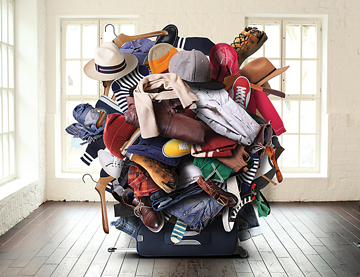If you have resolved to get organized in the new year, you are not alone. Along with eating better and exercising, getting organized is a perennial favorite on the resolution list. We know that better habits make us healthier and happier, but following through can be hard.
Forming new habits requires new thoughts, behaviors, and perseverance. Purchasing the latest diet book or running shoes will not get us in shape, nor can we cure clutter-itis with containers. Here are some tips to help you make your resolution stick.
Start with your vision.
A clear picture of what you want will help you stay the course. Create a vision board, write a goal statement, or just imagine what your organized life looks like. It doesn’t have to be perfect. It might be as simple as putting your keys in one place every day. Small, incremental change is easier to achieve – and sustain – than sweeping resolutions.
Find your motivation.
I ask clients to describe what will change when they are organized. This helps us tap into motivation. I hear the following: “I want my grandkids to visit!” or “I want to feel less stressed when I get home!” or “I want to spend weekends on my hobby – not my clutter!” So, why do you want to get organized?
Prepare to persevere.
The paper piles, the laundry heap, the crammed calendar, the attic full of artifacts – these didn’t appear in a day. It will take time to regain control. Bring patience and persistence to the task, and be ready to kick perfectionism to the curb. When things get off-track, remember – every step is progress. Don’t give up!

De-cluttering is important.
The new year offers some great opportunities to meet a few de-cluttering goals.
If you purchased or received an upgraded item over the holidays, donate, recycle, or throw away the old item. Avoid the temptation to hold on to spares. Toss things that are past their prime: food, cosmetics, medications, solo socks, and almost-empty containers. Remember to check the dates on your documents, too. We keep most papers far longer than we need to. When in doubt, consult a tax or legal professional.
For extra motivation, you might join an online de-cluttering challenge, like #30DayDecluttering, or color in a block of graph paper for each item you eliminate until you reach 2018 items in 2018. People I know who tried this in 2017 were amazed at how quickly they achieved this milestone.
Where to begin.
Some say start with all your clothes, others might suggest looking at one drawer. I say just start! No matter how you do it, sorting into categories will make decisions easier. Sort your whole kitchen or just the contents of one cupboard. Then, decide what can go. Focus on low-hanging fruit first – things that are broken, duplicates, single-taskers (think gadgets that only do one thing, i.e. banana slicer, pickle poker, corn grabbers), and items that have never been used. As you exercise your decision-making muscle, you can work your way up to tougher decisions.
While it will probably take some trial and error to find systems that work for you, here are a few techniques that have helped others get and stay organized:
1. Put solutions in the path of the problem. Make these so obvious, you practically trip over them. Losing keys? Put an eye-catching bowl where you enter the house. Clothes on a chair? Hang a hook nearby, and move the chair. Clothes on the floor? Put your hamper there. Papers on the counter? Put an action box, recycle bin, or a shredder where the mail usually lands.
2. Use prime storage areas – eye level and easy-to-access closets, shelves, and cabinets – for things you use often. Surface clutter happens when things don’t have a place to live, so remove less frequently used things to make room for the things you need at your fingertips.
3. Create zones by storing items together according to how they are used. For example, store mugs, grinder, filters, and sweeteners together for a coffee zone.
4. Maximize vertical space. If you can see the wall, you have storage potential. Ready-made or custom installations can turn a blank wall into abundant storage. Clear plastic over-the-door shoe-pockets transform the back of a door into six feet of storage.
5. Set up a clothes or toy rotation system. If you have overflow stuff (more than fits comfortably in your prime space), use labeled bins to store off-season, off-size, or extra items out of the way, and rotate them into use as needed.
6. When selecting organizing products, before you buy new items, get creative with what you have. Look online for clever organizing hacks! Follow these tips: choose clear containers; use individual drawer dividers for a custom fit; and use consistent patterns and shapes for exposed storage to create a pleasing display. In closets, use one consistent type of hanger.
With motivation, perseverance, and practice, you will be well on your way to a more organized lifestyle. However, if you get stuck or overwhelmed, it is smart to ask for help. Ask a family member or friend for help or find a certified professional organizer with the knowledge, skills, and specialized training to support your success.




